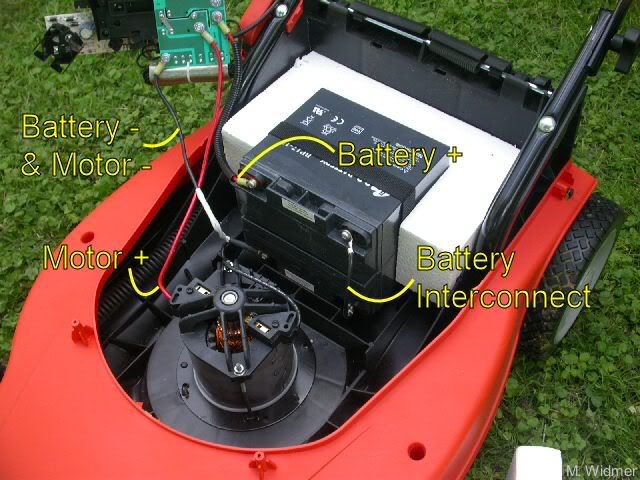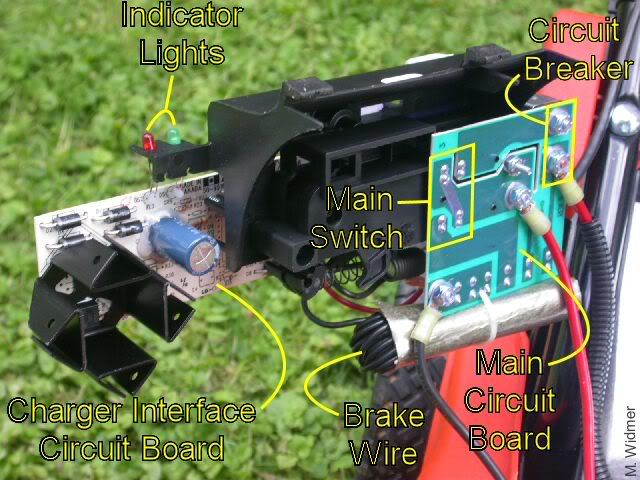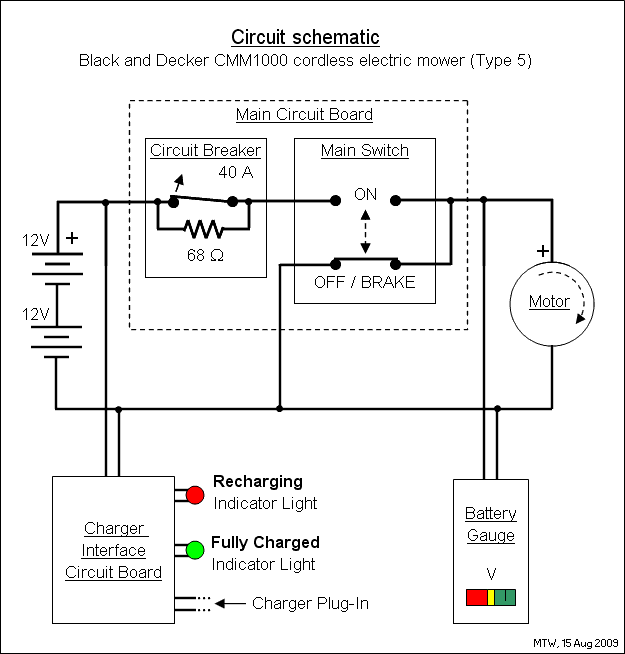Table of Contents
Today we'll be getting fairly technical. After some photos of the mower's innards, we'll check out the circuit schematic. This is intended for people with an understanding of basic electronics; if you're not one of those people, just enjoy the cool pictures!
Important note: if you have a question to ask, please ask it at Lawn Mower Forum, either in the Black & Decker area or the Electric & Battery Operated area at that website. I apologize for being unable to handle individual requests for help posted on this blog or sent by email.
When we remove the black plastic cover from the mower, we find that the two batteries are secured with a strap and two styrofoam blocks:
Click on photo for full picture.
Four cables are used to connect the batteries, motor, and main circuit board to one another:
Click on photo for full picture.
There are two printed circuit boards inside the mower. Black and Decker says nothing about them in the owner's manual, so I have taken it upon myself to name them:
1. The Main Circuit Board (green side visible in photo below) sends power from the battery to the motor. It contains the main switch and circuit breaker.
2. The Charger Interface Circuit Board (white side visible in photo) controls the recharging of the batteries, and is (apparently) not active when the mower is in use.
Click on photo for full picture.
Here is the circuit schematic for the CMM1000, Type 5. I imagine Types 1 through 5 may all have the same circuit, and perhaps the CMM1200 does as well, but I wouldn't swear by it.
Click on figure for full picture.
Some rambling observations about the circuit:
1. The two 12V batteries are wired in series to produce 24V. The batteries that come with the mower are from B.B.Battery, model # BP17-12 (17 Amp-hours, 12 Volts). I have since replaced them with 22 Amp-hour batteries of the same physical size. I'll write more about them in a future blog.
2. The Main Circuit Board controls the power to the motor via a circuit breaker and the main switch. The main switch is controlled by a cable that runs up to the handle where you, the user, pull on it using the switch lever.
3. If the mower is running and the operator releases the handle, the main switch returns to the "Off/Brake" position. This disconnects the battery and instead shorts the motor terminals. Without going into details, the short provides a fast breaking action for the motor rather than letting it spin down gradually. When the breaker opens and the handle is not released, the main switch stays in the "On" position and the motor spins down gradually.
4. The brake wire used to short the motor is rather long, and makes 14 loops of a roughly 5" x 1" area. (See 3rd photo.) Perhaps this is to provide some small inductance, but I don't understand exactly why this would be beneficial.
5. The circuit breaker is rated for 24V and 40A. It contains what appears to be a bimetal switch. Presumably the heat generated when the current rating is exceeded bends the bimetal into an open position. I have found that about 30 seconds after opening, the breaker switch on my mower has cooled enough to close and the mower may be restarted. I also found that heating directly with a hair dryer does not cause the bimetal to open, so it must be quite hot when it does.
6. There is a 68 ohm resistor inside the circuit breaker. It would provide a current path whenever the breaker opens, and is here presumably because of the inductive load presented by the motor. I'm admittedly curious about why the resistor is there and details of what it really does. (How I got in the position of prying open the circuit breaker is a story for another day.)
7. The Charger Interface Board is a maze of components and it would take a long time to break it down into a detailed schematic, so for now it remains something of a black box. The main features (not shown here) are 4 diodes + 1 capacitor (full wave rectifier?), an LM317 regulator, and a 14-pin IC. There are also oodles of resistors and some more diodes and capacitors. All I know for certain is, as shown in the schematic, that it contains the two indicator lights and receives the charger plug.





